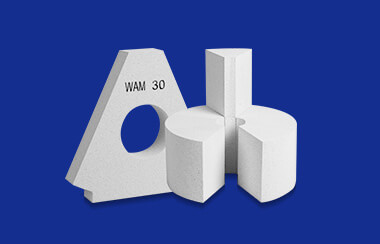The Best Solution For Energy Saving And Reducing CO2 Emission
The Best Solution For Energy Saving And Reducing CO2 Emission
 Tel: +86-532-85717690/85717352/85832089
Tel: +86-532-85717690/85717352/85832089 E-mail: wam@wamcn.net
E-mail: wam@wamcn.net
Refractory bricks, also known as fire bricks, are specially designed materials used to withstand high temperatures
and harsh conditions. They are primarily used in the construction of furnaces, kilns, and other thermal equipment. Understanding the composition of refractory bricks is essential to comprehend their properties and effectiveness in different applications. In this article, we will explore the materials that make up refractory bricks and their significance.

One of the most common types of refractory bricks is made from clay. These bricks are typically composed of a mixture of clay, grog (crushed and fired clay), and various additives. Clay is a versatile material that can withstand high temperatures without losing its shape and structural integrity. The presence of grog reinforces the bricks, making them more resistant to thermal stress.
Furthermore, the addition of certain additives enhances the performance of clay-based refractory bricks. For example, alumina is often added to increase the refractoriness of the bricks. It reduces the melting point of the bricks and improves their resistance to chemical attacks. Other additives, such as silicon carbide and magnesium oxide, can be incorporated to enhance the bricks' mechanical strength and thermal shock resistance.
Silica-based refractory bricks are another prevalent type of fire bricks. These bricks are primarily made from silica, which is known for its excellent thermal stability and resistance to high temperatures. Silica bricks can withstand temperatures as high as 1700°C (3092°F), making them suitable for applications involving extreme heat.
One of the key advantages of silica-based refractory bricks is their low thermal conductivity. This property allows them to prevent heat transfer, which is vital in insulating furnaces and kilns. Silica bricks also exhibit good resistance to acids and alkalis, making them suitable for applications involving chemical processes.
Magnesia-based refractory bricks are specifically designed to withstand extremely high temperatures. These bricks are composed primarily of magnesite, a mineral with excellent thermal conductivity and resistance to heat. Magnesia bricks can withstand temperatures above 2000°C (3632°F), making them ideal for applications in industries such as steelmaking and glass manufacturing.
In addition to magnesite, magnesia-based refractory bricks may also contain other materials such as chromite and dolomite. These additives improve the bricks' resistance to thermal shock and chemical corrosion. The high melting point and excellent thermal conductivity of magnesia bricks make them a preferred choice in environments where extreme heat and harsh conditions are prevalent.
Refractory bricks are essential materials in industries that involve high temperatures and harsh conditions. The composition of these bricks, whether clay-based, silica-based, or magnesia-based, determines their performance and suitability for specific applications. Understanding the properties and composition of refractory bricks is crucial in selecting the most appropriate material for various thermal processes. With ongoing advancements in materials science, the development of new and improved refractory brick compositions is expected, further enhancing their durability and performance in extreme environments.